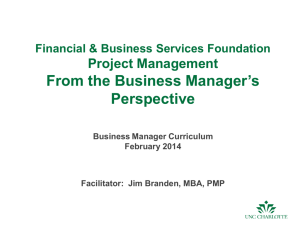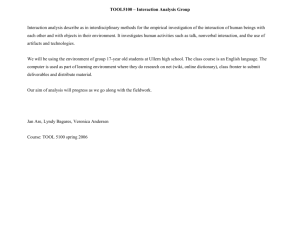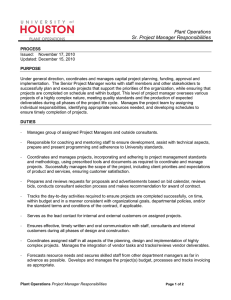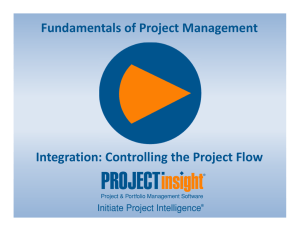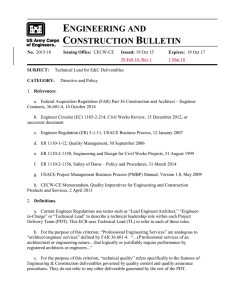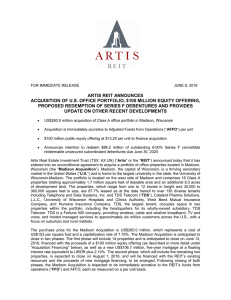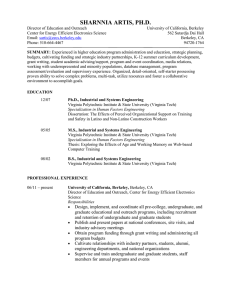PMI Requirements Definition Presentation 9-27
advertisement
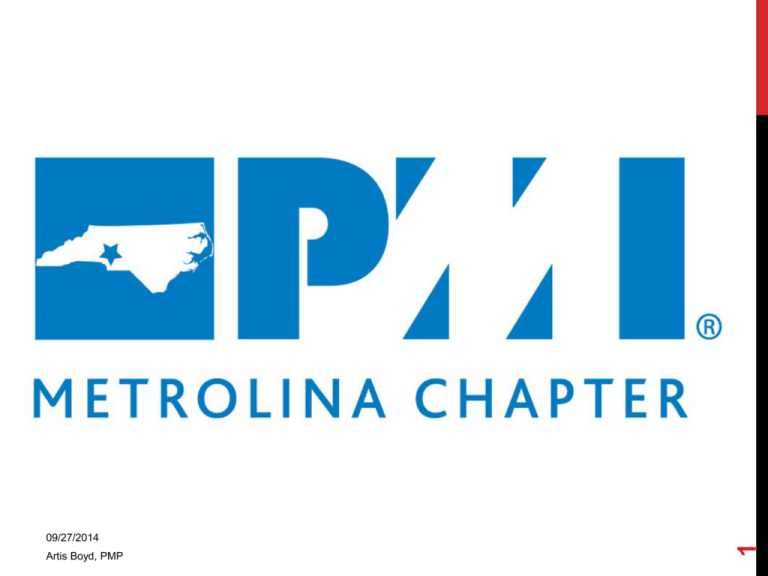
Artis Boyd, PMP 1 09/27/2014 BUSINESS AND FUNCTIONAL REQUIREMENTS “PROCESS IMPROVEMENT” 09/27/2014 Artis Boyd, PMP PROJECT SCOPING PROCESS IMPROVEMENT STEPS… Identify and select processes or opportunities Identify Stakeholders/ Customers Establish Requirements Develop Solutions Implement Action Plan Team members to include necessary business unit representatives Each step consists of elements to be completed and reviewed prior to moving forward Measurement will occur throughout the 5 Step Process Action plan may consists of simple action items or full project implementation 3 Communication is critical throughout 5 Step Process IDENTIFY AND SELECT PROCESSES OR OPPORTUNITIES… Key Deliverables Prioritized list of business needs Selected Project process to improve Opportunity Statement Project Charter(s): team members and stakeholders IDENTIFY STAKEHOLDERS/ CUSTOMERS… Key Deliverables List of Stakeholders/Customers Identify functional accountability (RACI Chart) Start w/ project sponsor Who’s in the critical path Who’s impacted - identify critical handoff points Identify potential baseline measures Activities, Volumes, Output, Quality Measures ESTABLISH REQUIREMENTS… Key Deliverables Define Requirements (Start from Project Charter) Facilitated Work Sessions Define requirements approach Flow Charts Fish Diagram Process Design Charting Analysis and Understanding of Current State vs. Future State Establish Baseline Measurements 11/05/2013 REQUIREMENTS- QUALITY CONTROL Translating User Requirements into Project Deliverables Lack of qualified resources Other 1% 3% Communication problems 14% 4 Poor scope control 15% Inadequate risk management 17% Poor requirements definition 1 3 2 50% GATHERING - REQUIREMENTS... Requirements Capture? Requirements analysis is “the set of tasks, knowledge, and techniques required to identify business activities/functions and determine solutions to business problems.” Focus on 6 knowledge areas of Enterprise Analysis Requirements Planning and Management Requirements Elicitation Requirements Analysis Requirements Communications Solution Assessment and Validation KEY CHALLENGES TO “REQUIREMENTS” CAPTURE Why Are Requirements So Difficult? 1. They are more than what the business “wants” 2. Unique knowledge and skills are required to develop the requirements 3. Project timelines may not allow sufficient time for requirements development 4. Specifying requirements to the right level of granularity is iterative 5. The use of requirements in related processes or frameworks is often unclear or misunderstood 6. Business changes cause requirements to change Project Meeting Facilitation: Addressing the Gap Causes of Meeting Ineffectiveness Lack of Effective Meeting Controls Incorrect or Inadequate Attendance Poor Preparation Other 10 PM & BA training doesn’t often include facilitation skills, meeting planning and group dynamics. INTERSECTION OF BUSINESS ANALYST AND PROJECT MANAGER PM and BA Tasks Project Management Business Analysis Directs the Team Listens Ensures project is delivered Ensures requirements are met Removes barriers Communicate! Manages project change Collaborate Manages the Work Breakdown Structure Identifies business issues Manages requirements Business Liaison DESIGN & PLAN MEETING MUST HAVE’S… “If a meeting is worth doing, it’s worth doing well.” Do the Necessary Planning 1.Purpose 2.Desired Outcome(s) 3.Invite (duration & location) 4.Basic Agenda* • How long will each item take? • Who is responsible for leading the discussion? • How will each topic be covered? Discussion, Brainstorming, Round Robin, Reporting • What is the expected outcome, if appropriate? 5.Mandatory Participants 6.Necessary Pre-work (if any) 12 DESIGN & PLAN FACILITATOR’S TOOLS Ice Breakers Nominal Group Technique MultiVoting Brainstorming Delphi Technique Avoiding Group Think • Ease group contribution • Prioritize issues to achieve consensus • Choose fairly between many options • Generate many radical ideas • Achieve consensus among experts • Avoid fatal flaws in group decision making 13 DESIGN & PLAN MEETING MUST HAVE’S… Before the Meeting: Think Ahead Worst case scenario (contingency plan)? Best case scenario? How do you want the meeting to flow? How will you introduce the issue(s) at hand? How can attendees be made ready to have a good meeting? • • • Intel Corporation Conference Room Posters Do you know the purpose of this meeting? Do you have an agenda? Do you know your role? 14 TOOLS FOR KEEPING MEETINGS ON TARGET “A productive meeting is a well planned, well managed journey that engages participants and achieves its intended goal.” Meeting Purpose Know what you need to accomplish Agenda The agenda is the roadmap. Use it as a checklist for progress or to postpone topics that will be addressed later. Be Prepared Provide materials when possible Prep critical attendees with your expectations of their role. *A survey of 150 corporate meetings found that half had no written agenda, less then one third captured minutes, and only one in ten followed through with next steps. 15 GUIDE AND CONTROL Set ground rules Review objectives and agenda Get things flowing Keep up the momentum and energy Listen, engage, and include Monitor checkpoints and summarize Intervene, if necessary 16 GUIDE AND CONTROL EXAMPLE: PROJECT MEETINGS 1.Roll Call 2.Accomplishments • • List successes since the last status update Browse the quarterly recognition (or annual Volunteer Service Awards) for your team members and share their good press! 3.Check In - the status of work 4.Work scheduled but not completed 5.Cross-project issues Possible Other: A human element A positive quote (Values.com) “A smile is a curve that sets everything straight.” Phyllis Diller A well timed comic 17 RECORD AND FOLLOW UP Ensure understanding Begins DURING the meeting Use words that the group chooses Record decisions and actions Plan enough time at the end to recap/agree Check for fairness and accuracy Obtain responsibility and commitment Follow up after the meeting 18 HOW CAN I MAKE OUR PROJECTS SUCCESSFUL? “If you fail to plan, you plan to fail!” Benjamin Franklin SO, DO YOU PLAN? This is how it works with strategic planning. It’s not the plan…it’s the planning. When your team works together to identify the issues, develop the strategy, build the schedule, assign responsibilities and assess the costs, success is almost assured. Team members know what to do, when to do it, why it’s important and how any changes will affect others

